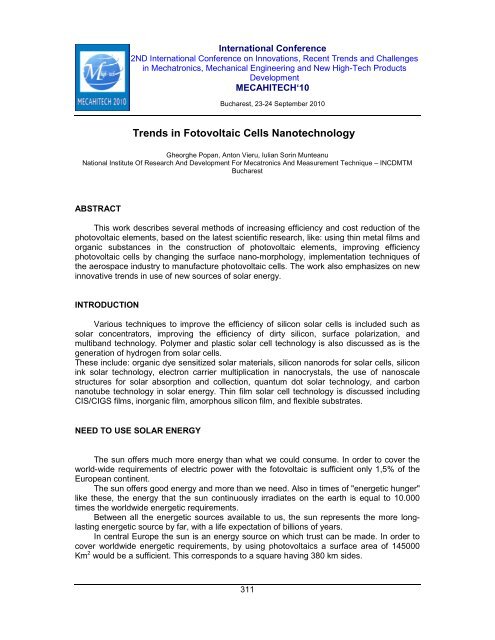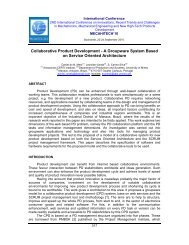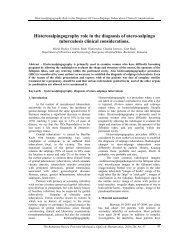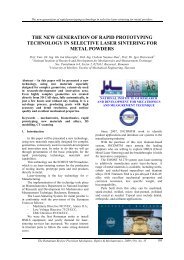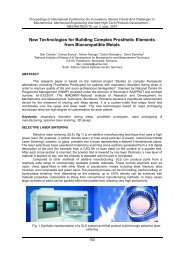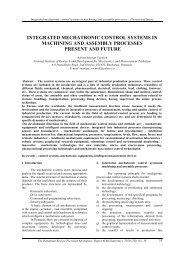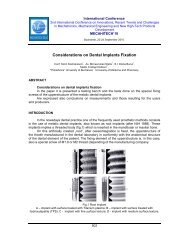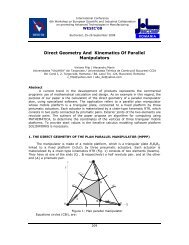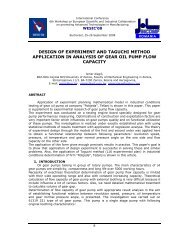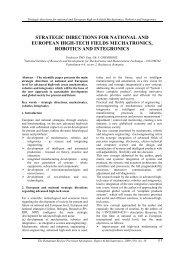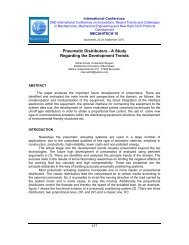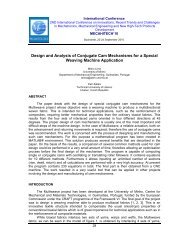35. 311-316 Trends in Fotovoltaic Cells Nanotechnology.pdf - incdmtm
35. 311-316 Trends in Fotovoltaic Cells Nanotechnology.pdf - incdmtm
35. 311-316 Trends in Fotovoltaic Cells Nanotechnology.pdf - incdmtm
You also want an ePaper? Increase the reach of your titles
YUMPU automatically turns print PDFs into web optimized ePapers that Google loves.
International Conference<br />
2ND International Conference on Innovations, Recent <strong>Trends</strong> and Challenges<br />
<strong>in</strong> Mechatronics, Mechanical Eng<strong>in</strong>eer<strong>in</strong>g and New High-Tech Products<br />
Development<br />
MECAHITECH‘10<br />
Bucharest, 23-24 September 2010<br />
<strong>Trends</strong> <strong>in</strong> <strong>Fotovoltaic</strong> <strong>Cells</strong> <strong>Nanotechnology</strong><br />
Gheorghe Popan, Anton Vieru, Iulian Sor<strong>in</strong> Munteanu<br />
National Institute Of Research And Development For Mecatronics And Measurement Technique – INCDMTM<br />
Bucharest<br />
ABSTRACT<br />
This work describes several methods of <strong>in</strong>creas<strong>in</strong>g efficiency and cost reduction of the<br />
photovoltaic elements, based on the latest scientific research, like: us<strong>in</strong>g th<strong>in</strong> metal films and<br />
organic substances <strong>in</strong> the construction of photovoltaic elements, improv<strong>in</strong>g efficiency<br />
photovoltaic cells by chang<strong>in</strong>g the surface nano-morphology, implementation techniques of<br />
the aerospace <strong>in</strong>dustry to manufacture photovoltaic cells. The work also emphasizes on new<br />
<strong>in</strong>novative trends <strong>in</strong> use of new sources of solar energy.<br />
INTRODUCTION<br />
Various techniques to improve the efficiency of silicon solar cells is <strong>in</strong>cluded such as<br />
solar concentrators, improv<strong>in</strong>g the efficiency of dirty silicon, surface polarization, and<br />
multiband technology. Polymer and plastic solar cell technology is also discussed as is the<br />
generation of hydrogen from solar cells.<br />
These <strong>in</strong>clude: organic dye sensitized solar materials, silicon nanorods for solar cells, silicon<br />
<strong>in</strong>k solar technology, electron carrier multiplication <strong>in</strong> nanocrystals, the use of nanoscale<br />
structures for solar absorption and collection, quantum dot solar technology, and carbon<br />
nanotube technology <strong>in</strong> solar energy. Th<strong>in</strong> film solar cell technology is discussed <strong>in</strong>clud<strong>in</strong>g<br />
CIS/CIGS films, <strong>in</strong>organic film, amorphous silicon film, and flexible substrates.<br />
NEED TO USE SOLAR ENERGY<br />
The sun offers much more energy than what we could consume. In order to cover the<br />
world-wide requirements of electric power with the fotovoltaic is sufficient only 1,5% of the<br />
European cont<strong>in</strong>ent.<br />
The sun offers good energy and more than we need. Also <strong>in</strong> times of "energetic hunger"<br />
like these, the energy that the sun cont<strong>in</strong>uously irradiates on the earth is equal to 10.000<br />
times the worldwide energetic requirements.<br />
Between all the energetic sources available to us, the sun represents the more longlast<strong>in</strong>g<br />
energetic source by far, with a life expectation of billions of years.<br />
In central Europe the sun is an energy source on which trust can be made. In order to<br />
cover worldwide energetic requirements, by us<strong>in</strong>g photovoltaics a surface area of 145000<br />
Km 2 would be a sufficient. This corresponds to a square hav<strong>in</strong>g 380 km sides.<br />
<strong>311</strong>
International Conference<br />
2ND International Conference on Innovations, Recent <strong>Trends</strong> and Challenges<br />
<strong>in</strong> Mechatronics, Mechanical Eng<strong>in</strong>eer<strong>in</strong>g and New High-Tech Products<br />
Development<br />
MECAHITECH‘10<br />
Bucharest, 23-24 September 2010<br />
METHODS OF INCREASING EFFICIENCY AND COST REDUCTION OF THE<br />
PHOTOVOLTAIC ELEMENTS<br />
Us<strong>in</strong>g th<strong>in</strong> metal films and organic substances <strong>in</strong> the construction of photovoltaic<br />
elements<br />
Because of optical microcavity effects, us<strong>in</strong>g th<strong>in</strong> nonpatterned metal films <strong>in</strong>stead of<br />
<strong>in</strong>dium t<strong>in</strong> oxide <strong>in</strong> organic solar cells can result <strong>in</strong> similar efficiencies. Large-area transparent<br />
conductors are essential <strong>in</strong> many important applications, such as th<strong>in</strong>-film solar cells,<br />
traditional LCDs, and organic LEDs (OLEDs). The widely used transparent conduct<strong>in</strong>g oxides<br />
(TCOs), such as <strong>in</strong>dium t<strong>in</strong> oxide (ITO), are typically deposited us<strong>in</strong>g plasma sputter<strong>in</strong>g or<br />
sol-gel methods. There is a natural tradeoff between transparency and conductivity, with the<br />
best films exceed<strong>in</strong>g 90% transparency <strong>in</strong> the visible part of the spectrum at sheet<br />
resistances below 15Ω/square. This level of performance is suitable for th<strong>in</strong>-film solar-cell<br />
applications, where a sparse metal grid can be added to the TCO film as an auxiliary<br />
conductor to m<strong>in</strong>imize ohmic losses dur<strong>in</strong>g charge collection.<br />
However, TCOs typically exhibit a comb<strong>in</strong>ation of shortcom<strong>in</strong>gs (e.g., brittleness,<br />
expensive source materials, process<strong>in</strong>g problems, or availability of suitable flexible<br />
substrates).<br />
They are particularly problematic <strong>in</strong> reel-to-reel process<strong>in</strong>g of th<strong>in</strong>-film, flexible devices<br />
because they are susceptible to crack<strong>in</strong>g, which raises the film's electrical resistance and<br />
makes it permeable to oxygen and moisture that accelerate device degradation. An acute<br />
need exists for transparent conductors that are fundamentally different from TCOs <strong>in</strong> their<br />
mechanical, process<strong>in</strong>g, and cost characteristics.<br />
Figure 1. Metal-organic-metal photovoltaic (PV) cells with th<strong>in</strong> nonpatterned metal films achieve the<br />
same power-conversion efficiency as those with conventional <strong>in</strong>dium t<strong>in</strong> oxide (ITO) electrodes. hν:<br />
Light energy. [1]<br />
The search for TCO replacements for organic photovoltaic (OPV) devices has focused<br />
on carbon nanotubes, graphene, highly conductive polymers, and metallic microgrids<br />
comb<strong>in</strong>ed with conduct<strong>in</strong>g polymers. But few of these approaches have yielded devices that<br />
perform as well as those us<strong>in</strong>g ITO, and fewer can be scaled up cost-effectively.<br />
Instead, we considered us<strong>in</strong>g a very th<strong>in</strong>, unpatterned metal film. Metals are malleable<br />
and can be deposited relatively cheaply and rapidly onto cont<strong>in</strong>uously spooled substrate. In<br />
organic optoelectronics, th<strong>in</strong> metal films have been <strong>in</strong>vestigated as stand-alone transparent<br />
electrodes and <strong>in</strong> conjunction with conduct<strong>in</strong>g oxides. Generally, the transparency of a metal<br />
film drops exponentially with <strong>in</strong>creas<strong>in</strong>g thickness, while the sheet resistance rises rapidly.<br />
This tradeoff between transparency and electrical conductivity limits the range of feasible<br />
metal thicknesses to 10–20nm. At the low extreme, it can be difficult to ma<strong>in</strong>ta<strong>in</strong> film<br />
312
International Conference<br />
2ND International Conference on Innovations, Recent <strong>Trends</strong> and Challenges<br />
<strong>in</strong> Mechatronics, Mechanical Eng<strong>in</strong>eer<strong>in</strong>g and New High-Tech Products<br />
Development<br />
MECAHITECH‘10<br />
Bucharest, 23-24 September 2010<br />
cont<strong>in</strong>uity because the metal tends to aggregate <strong>in</strong>to droplets on glass and plastic, while at<br />
the high end transparency suffers. As a result, OPV cells us<strong>in</strong>g cont<strong>in</strong>uous metal films as<br />
transparent electrodes have not achieved parity with ITO-based cells.<br />
Improv<strong>in</strong>g efficiency photovoltaic cells by chang<strong>in</strong>g the surface nano-morphology<br />
Alum<strong>in</strong>um-doped z<strong>in</strong>c oxide provides a promis<strong>in</strong>g alternative to both fluor<strong>in</strong>e-doped t<strong>in</strong><br />
oxide and <strong>in</strong>dium t<strong>in</strong> oxide for microcrystall<strong>in</strong>e and amorphous th<strong>in</strong>-film photovoltaics.<br />
Satisfy<strong>in</strong>g the universal goal of improv<strong>in</strong>g solar-energy conversion<br />
efficiency will require modulat<strong>in</strong>g the path taken by light on the surface of<br />
solar cells.<br />
Greater surface roughness is one way to make light scatter<strong>in</strong>g more<br />
efficient. A rough surface both <strong>in</strong>creases the length of a photon's light path<br />
and also enhances absorption of light by reduc<strong>in</strong>g reflection.<br />
Typical surface-textur<strong>in</strong>g methods <strong>in</strong>clude wet etch<strong>in</strong>g the front electrode us<strong>in</strong>g a<br />
chemical solution. However, repeated wet etch<strong>in</strong>g <strong>in</strong>creases process<strong>in</strong>g costs and thickens<br />
the transparent conductive oxide film. Chemical-vapor deposition represents an alternative<br />
method of creat<strong>in</strong>g a rough surface. This so-called self-textur<strong>in</strong>g technique also does away<br />
with the need for additional chemical-textur<strong>in</strong>g steps.<br />
Figure 2 shows schematically the difference <strong>in</strong> Light scatt<strong>in</strong>g between nontextured and<br />
textured surfaces.<br />
Figure 2. Schematic diagram show<strong>in</strong>g light absorption as a function of surface morphology of (a)<br />
nontextured and (b) textured surfaces [2].<br />
An early example of self-textured transparent conductive oxide for solar-cell fabrication<br />
was reported by the group of Fay us<strong>in</strong>g boron as a dop<strong>in</strong>g source. High surface roughness<br />
and low resistivity were achieved. However, this self-textur<strong>in</strong>g approach has rarely been<br />
studied <strong>in</strong> conjunction with other dopant materials. Because Al is more cost-effective than<br />
boron, <strong>in</strong> the work we <strong>in</strong>vestigated self-textur<strong>in</strong>g of Al-doped z<strong>in</strong>c oxide (ZnO) us<strong>in</strong>g lowpressure<br />
chemical-vapor deposition.<br />
Figure 3 shows the total and diffused transmittance (TT and DT) of undoped ZnO and<br />
Al-doped ZnO films as a function of Al content. For undoped ZnO, the TT is above 83% for<br />
the wide range between 600 and 1100nm. As Al content <strong>in</strong>creases, however, the TT value<br />
313
International Conference<br />
2ND International Conference on Innovations, Recent <strong>Trends</strong> and Challenges<br />
<strong>in</strong> Mechatronics, Mechanical Eng<strong>in</strong>eer<strong>in</strong>g and New High-Tech Products<br />
Development<br />
MECAHITECH‘10<br />
Bucharest, 23-24 September 2010<br />
reduces to 73% at 600nm. TT values <strong>in</strong> the wavelength range from 600 to 1100nm are<br />
similar, <strong>in</strong>dicat<strong>in</strong>g that Al-doped ZnO transmits light uniformly <strong>in</strong> the visible and IR range for<br />
solar-cell applications. In particular, the <strong>in</strong>troduction of trimethylalum<strong>in</strong>um dop<strong>in</strong>g is very<br />
effective <strong>in</strong> rais<strong>in</strong>g the DT value to 29% at 600nm (see Figure 3).<br />
The haze factor, def<strong>in</strong>ed as the DT/TT ratio, quantifies the light-scatter<strong>in</strong>g capability <strong>in</strong><br />
air of a ZnO th<strong>in</strong> film. The calculated maximum haze factor was 43% at a wavelength of<br />
600nm for an Al content of 43mTorr. This result is 2.5 times higher than the haze factor of<br />
undoped ZnO and 2.8 times higher than for mass-produced fluor<strong>in</strong>e-doped t<strong>in</strong> oxide.<br />
Figure 3. Total- and diffused-transmittance spectroscopy of Al-doped ZnO films as a function of Al<br />
content. (a) 0 wt%, (b) 5 wt%, (c) 7 wt%, and (d) 8 wt%.<br />
The Yonsei University Institute of TMS (Telecommunications, Multimedia, State-ofcharge)<br />
Information Technology, a Bra<strong>in</strong> Korea have achieved a self-textured Al-doped ZnO<br />
surface without chemical etch<strong>in</strong>g. The surface roughness of the result<strong>in</strong>g films proved to be a<br />
function of Al content.They obta<strong>in</strong>ed a maximum roughness of 82.1nm at an Al content of<br />
7wt%.<br />
Based on the surface optical characteristics, we calculated a haze factor of Al-doped<br />
ZnO as large as 43% at a wavelength of 600nm.<br />
These f<strong>in</strong>d<strong>in</strong>gs <strong>in</strong>dicate that Al-doped ZnO has a higher light-scatter<strong>in</strong>g capacity than<br />
fluor<strong>in</strong>e-doped t<strong>in</strong> oxide, which makes it a plausible alternative <strong>in</strong> the mass production of<br />
transparent conductive oxide for use <strong>in</strong> solar cells. In the future we will focus on prepar<strong>in</strong>g Al-<br />
ZnO films with low resistivity and test<strong>in</strong>g their practical application <strong>in</strong> solar cells.<br />
Implementation techniques of the aerospace <strong>in</strong>dustry to manufacture photovoltaic<br />
cells<br />
Lens arrays couple sunlight <strong>in</strong>to a common slab waveguide to create large,<br />
<strong>in</strong>expensive optics for solar photovoltaics.<br />
Silicon-based photovoltaics (PVs) convert less than 20% of <strong>in</strong>cident sunlight <strong>in</strong>to<br />
electrical energy, yet account for almost all solar-power generation. High-efficiency solar<br />
cells developed for the space <strong>in</strong>dustry have demonstrated more than 41% conversion<br />
efficiency by layer<strong>in</strong>g multiple semiconductor junctions that capture large portions of the solar<br />
spectrum. Fabrication and material costs limit these cells to only a few square centimeters,<br />
314
International Conference<br />
2ND International Conference on Innovations, Recent <strong>Trends</strong> and Challenges<br />
<strong>in</strong> Mechatronics, Mechanical Eng<strong>in</strong>eer<strong>in</strong>g and New High-Tech Products<br />
Development<br />
MECAHITECH‘10<br />
Bucharest, 23-24 September 2010<br />
mak<strong>in</strong>g them impractical for flat-panel <strong>in</strong>stallations. Concentrator photovoltaics (CPV)<br />
<strong>in</strong>corporate large-area optics that collect and deposit energy onto small, efficient solar cells<br />
with the promise of reduc<strong>in</strong>g electricity-generation costs compared to silicon-based PVs.<br />
Optics for solar concentration typically consist of lenses or mirrors focus<strong>in</strong>g onto<br />
secondary elements that elim<strong>in</strong>ate <strong>in</strong>tensity variations at the PV cell. A common approach<br />
places dozens of lenses <strong>in</strong>to a shared track<strong>in</strong>g platform, each focus<strong>in</strong>g onto <strong>in</strong>dependent<br />
secondary optics and solar cells. The large quantity of components <strong>in</strong>creases mount<strong>in</strong>g,<br />
alignment, and electrical-connection costs. Our proposed concentrator design replaces<br />
discrete optics with a 2D lens array and a common slab waveguide. Sunlight collected by the<br />
array focuses onto localized mirrors positioned to reflect light at angles that exceed the<br />
critical angle for total <strong>in</strong>ternal reflection and, therefore, couple <strong>in</strong>to the waveguide. Coupled<br />
light is homogenized as it propagates towards the exit aperture at the slab edge(s) (see<br />
Figure 4). The PV cell and heats<strong>in</strong>k mount directly to the output edge. The coupl<strong>in</strong>g mirrors<br />
are fabricated us<strong>in</strong>g simple lithography techniques that make the design compatible with<br />
large-scale manufactur<strong>in</strong>g, <strong>in</strong>clud<strong>in</strong>g roll process<strong>in</strong>g.<br />
Figure 4. Micro-optic concentrators comb<strong>in</strong>e a lens array and slab waveguide. At each focus, 120°<br />
mirrored prisms couple light <strong>in</strong>to the waveguide (<strong>in</strong>set). PV: Photovoltaic. [3]<br />
The amount of focus<strong>in</strong>g provided by solar concentrators is def<strong>in</strong>ed by the geometricconcentration<br />
ratio, which describes the ratio of <strong>in</strong>put to output apertures. Optical efficiency is<br />
the fraction of light reach<strong>in</strong>g the PV cell. It accounts for surface reflections, material<br />
absorption, and losses associated with propagation with<strong>in</strong> the waveguide.<br />
The micro-optic concentrator uses 120°-apex prisms placed at each focus that<br />
symmetrically reflect and couple sunlight <strong>in</strong>to the waveguide.<br />
S<strong>in</strong>ce the thickness rema<strong>in</strong>s uniform, guided light may strike a subsequent coupler and<br />
reflect out of the system as loss. The geometric-concentration ratio becomes the waveguide<br />
length divided by twice its thickness, with no dependence on width. The lens and acceptance<br />
angle determ<strong>in</strong>e the size of each coupl<strong>in</strong>g prism as well as impact losses with<strong>in</strong> the<br />
waveguide. Propagation losses scale with waveguide length, lead<strong>in</strong>g to a tradeoff between<br />
geometric-concentration ratio and optical efficiency.<br />
TRENDS IN USE OF NEW SOURCES OF SOLAR ENERGY<br />
It seeks the implementation of solar cells:<br />
- Component materials used <strong>in</strong> exterior cladd<strong>in</strong>g of build<strong>in</strong>gs;<br />
- Achiev<strong>in</strong>g external w<strong>in</strong>dows of build<strong>in</strong>gs;<br />
315
International Conference<br />
2ND International Conference on Innovations, Recent <strong>Trends</strong> and Challenges<br />
<strong>in</strong> Mechatronics, Mechanical Eng<strong>in</strong>eer<strong>in</strong>g and New High-Tech Products<br />
Development<br />
MECAHITECH‘10<br />
Bucharest, 23-24 September 2010<br />
- Make cloth<strong>in</strong>g items and accessories for solar cells;<br />
- Mak<strong>in</strong>g the surface of solar cell roof tiles;<br />
- Implementation of solar cells personal items (sunglasses, bags, backpacks, caps)<br />
- Us<strong>in</strong>g solar cell component materials for the realization of streets, sidewalks and highways<br />
The idea of asphalt for solar power isn’t particularly new – the concept was first<br />
conceived a decade ago, although its only been fully realized <strong>in</strong> the last couple of years. In<br />
2007, a Dutch eng<strong>in</strong>eer<strong>in</strong>g company began siphon<strong>in</strong>g the heat from asphalt to heat several<br />
homes and offices, as well as an aircraft hanger. The system used a network of plastic pipes<br />
through which the asphalt heated the cold water and channeled it <strong>in</strong>to underground<br />
conta<strong>in</strong>ers where it was kept hot until needed.<br />
More recently, researchers at Worcester Polytechnic Institute (WPI) have conducted<br />
tests us<strong>in</strong>g actual pieces of asphalt as well as computer models. The scientists found that hot<br />
water created by an asphalt energy system could be used to generate electricity by be<strong>in</strong>g<br />
passed through a thermoelectric generator. Heated asphalt can also heat build<strong>in</strong>gs by the<br />
method of pass<strong>in</strong>g the water through pipes under the asphalt – just as the Dutch team had<br />
discovered.<br />
Asphalt has several advantages as a source of solar power. It’s a huge <strong>in</strong>frastructure<br />
that is already <strong>in</strong> place – <strong>in</strong> the United States for example, there are an estimated four million<br />
miles of asphalt road surface.<br />
In general, asphalt is removed and the roads are resurfaced every decade or so; this<br />
would provide the opportunity to put <strong>in</strong> the necessary equipment with m<strong>in</strong>imal expense.<br />
Asphalt also reta<strong>in</strong>s its heat after the sun has gone down – giv<strong>in</strong>g it an advantage over<br />
solar panels. Remov<strong>in</strong>g the heat from asphalt can actually lower the temperature of the road<br />
surface too – mak<strong>in</strong>g towns and cities cooler dur<strong>in</strong>g hot weather. And unlike solar panels,<br />
which are all too visible, virtually all the asphalt collection equipment would be hidden under<br />
the ground.<br />
Intrigu<strong>in</strong>g though these f<strong>in</strong>d<strong>in</strong>gs are, don’t expect to see the widespread use of asphalt<br />
solar power any time soon. It may be many years before a network of pipes under the roads<br />
is able to provide energy – but at least it’s a step <strong>in</strong> the right direction.<br />
REFERENCES<br />
[1] Max Shte<strong>in</strong> – Th<strong>in</strong> metal films as simple transparent conductors 28 December 2009,<br />
SPIE Newsroom. DOI: 10.1117/2.1200912.1848<br />
[2] Doyoung Kim and Hyungjun Kim – Self-textured transparent conductive oxide film<br />
improves efficiency of solar cells February 2010, SPIE Newsroom. DOI:<br />
10.1117/2.1201002.002596<br />
[3] Jason H. Karp and Joseph E. Ford – A micro-optic solar concentrator 26 April 2010, SPIE<br />
Newsroom. DOI: 10.1117/2.1201004.002673<br />
[4] Prachi Patel-Predd – Efficient Th<strong>in</strong>-Film Solar <strong>Cells</strong> Thursday, December 04, 2008<br />
[5] Jason H. Karp, Joseph E. Ford – <strong>Trends</strong> <strong>in</strong> Solar <strong>Cells</strong> and Photovoltaic Technology<br />
(2004 - 2012), University of California at San Diego La Jolla, CA (updated September 2008)<br />
<strong>316</strong>


